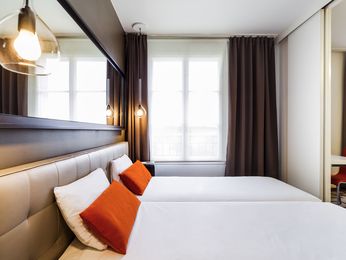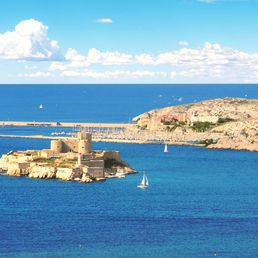Notre-Dame-de-la-Garde, a City’s Symbol of Marseille

All our apartments in Marseille
Member rate -5%
Member rate -5%
Built between 1853 and 1864, this Neo-Byzantine basilica dominates the city of Marseille. Its belfry, 46m high, is capped by a huge gilded statue of the Virgin Mary. The lavishly decorated interior has coloured marble and mosaic facings. The Basilica started life in 1214 when Pierre, a priest of Marseilles, built a small sanctuary dedicated to the Virgin Mary on the rocky triangle that forms the top of a hill facing the town of Marseille, which was very small at the time.
The “Our Lady of La Garde” sanctuary quite naturally took the name of the hill which was called “La Garde”. After the siege of Marseille in 1524 when the Holy Roman Emperor attempted to capture the town to reunite two parts of his empire, Francis I decided to build two fortresses to protect the city. One was on the Island of If (now the Chateau d’If) and the other was built around the chapel at La Garde. Very unusually Francis I decided that the faithful of the city could continue to have access to the chapel in peacetime and the drawbridge was left lowered during the day.
In 1851, the administrators of Notre-Dame de la Garde asked the Minister of War, without really expecting a positive reply, for permission to pull down the little chapel and replace it with a bigger sanctuary surmounted by a bell-tower. Like the Chapel, this new sanctuary would also be inside the fort. In 1852 the request was approved and architect Jacques Henri Espérandieu who was only 23 years old designed a church in neo-roman style. In contrast to the main church, the crypt is very plain and bare except for a few columns.
During the Second World War, the barracks of the fortress were taken over by the German army. The sanctuary was liberated in August 1944 and it finally lost its military status in 1954. Visitors today can see the original crypt from the 13th century, five statues of the Virgin Mary and above the porch two marble statues of the prophet Isaiah and John the apostle. Inside the basilica are several other important marble statues.
The Basilica is open every day and services are held several times during the day in both the Crypt and the Basilica. Visits for groups can be organised, free of charge, by applying to the church. Themes available are architecture, mosaics and the history of the site.







